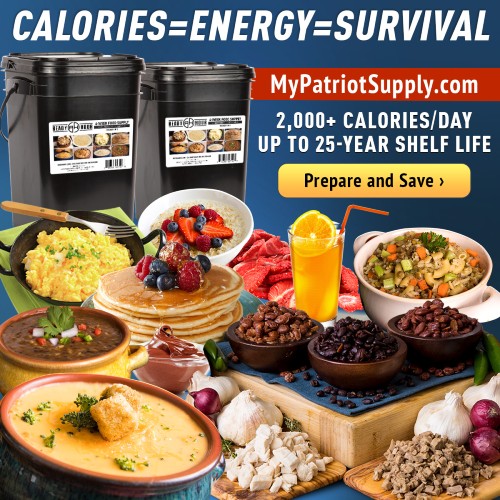- Watch The JD Rucker Show every day to be truly informed.
(Alt-Market)—I have said it many times in the past but I think it bears repeating once again: If you want to understand why world events happen the way they do, you must understand the goals and influence of globalist institutions. You must accept the fact that these people create most of the national and international disasters you and I have to deal with on a regular basis and oftentimes they create these disasters deliberately.
Yes, I know, there are plenty of skeptics out there that think all geopolitics and crisis events are random or a product of bureaucratic stupidity; and those people are wrong. They have no idea what they’re talking about because they’re basing this conclusion on assumptions rather than facts and research. Make no mistake, there’s a good reason why it feels like the whole world has gone crazy all at once.
The primary purpose of the globalists is to erase national borders and homogenize all countries and cultures under one economic and governmental system. They have openly admitted to this plan on numerous occasions. One of the most revealing quotes on the agenda comes from Clinton Administration Deputy Secretary of State Strobe Talbot, who stated in Time magazine that:
“In the next century, nations as we know it will be obsolete; all states will recognize a single, global authority… National sovereignty wasn’t such a great idea after all.”
He adds in the same article a lesser known quote:
“…The free world formed multilateral financial institutions that depend on member states’ willingness to give up a degree of sovereignty. The International Monetary Fund can virtually dictate fiscal policies, even including how much tax a government should levy on its citizens. The General Agreement on Tariffs and Trade regulates how much duty a nation can charge on imports. These organizations can be seen as the protoministries of trade, finance and development for a united world.”
The people who push for this agenda are generally members of a number of globalist organizations, from the Council on Foreign Relations to the Tavistock Institute to the World Economic Forum to the IMF or World Bank, not to mention the Bank for International Settlements and the Council For Inclusive Capitalism. However, these think-tank groups are only part of the bigger picture. They are supported by some of the largest banking and investment corporations in the world, including Goldman Sachs, JP Morgan, HSBC, Vanguard, Blackrock, etc.
If you want to know why mass illegal immigration is a growing crisis at this time and why the current government has been actively trying to enforce an open border police in the US, simply look into the financial aspects of pro-illegal immigration lobbying groups and think tanks pushing open borders messaging into the mainstream. You will find many of these banks and investment funds connected to them in one way or another.
For example, the list of companies backing the Governor of New York’s plan to subsidize illegal aliens entering the state is very revealing. If they’re allowed to continue offering incentives to illegals then those people will continue trying to come to the US; this isn’t complicated. The conspiracy is out in the open.
Admitting To The Agenda, Then Painting It As A Positive
For the first few years of Joe Biden’s presidency, he and his cohorts attempted to deny there was any mass illegal migration problem at all. However, when media coverage (mostly independent) began to expose the enormous caravans of illegals overwhelming border towns like El Paso, Texas, he was forced to acknowledge that the crisis was in fact a crisis.
But, if you thought that forcing Biden to admit to the migrant disaster was going to force him to do something about it, you were sorely mistaken. The reason mass immigration exists right now is exactly because the Biden Administration and globalist institutions are offering free handouts to “asylum seekers.” All they have to do to stop the rising tide of illegals is to stop offering them free stuff. Clearly, the political elites have no intention of doing this.
Instead, government officials, think-tanks and the media have decided that since they’re now pressed to admit that mass immigration and open borders are real, they’re going to spin the crisis as if it’s actually a good thing for America.
In a narrative similar to the one used by EU officials to justify their support of the invasion of Islamic fundamentalists from 2014 onward, American elites claim that western nations are “desperate for a younger population” which can fill the “needs of the labor market.” They claim than mass migrations into the west are “good for the economy.”
This was also the primary message of a World Economic Forum conference on migration and labor held in March. The globalist organization discussed how open borders and mass immigration could be framed as a “positive” in terms of economic advantages. And the talking points derived from WEF events always find their way into the corporate media. The main takeaway? Protectionism (of national borders) is bad and countries that engage in it will be at an economic disadvantage.
Don’t just survive — THRIVE! Prepper All-Naturals has freeze-dried steaks for long-term storage. Don’t wait for food shortages to get worse. Stock up today. Use promo code “jdr” at checkout for 25% off!
Since last month there’s been a hailstorm of establishment media articles and news reports suggesting that mass immigration will boost GDP and make America stronger. These assertions are all built on a single line from a single report from the Congressional Budget Office which states:
“In our projections, the deficit is also smaller than it was last year because economic output is greater, partly as a result of more people working. The labor force in 2033 (EDITOR’S NOTE: Do they mean 2023?) is larger by 5.2 million people, mostly because of higher net immigration. As a result of those changes in the labor force, we estimate that, from 2023 to 2034, GDP will be greater by about $7 trillion and revenues will be greater by about $1 trillion than they would have been otherwise. We are continuing to assess the implications of immigration for revenues and spending.”
Bloomberg recently published an article boasting that this line from the CBO report shows that the rising fears among Americans over illegal immigration are unfounded. They question why the migrant crisis is a top issue going into the 2024 elections and cite a number of major banking institutions that have adjusted their US fiscal outlook into the positive because of the CBO’s data point and higher immigration. Bloomberg quotes the HSBC:
“Immigration is not just a highly charged social and political issue, it is also a big macroeconomic one,” Janet Henry, global chief economist at HSBC Holdings Plc, wrote in a note to clients Tuesday. No advanced economy is benefiting from immigration quite like the U.S., and “the impact of migration has been an important part of the U.S. growth story over the past two years.”
Firstly, let’s clarify something in terms of the CBO’s theory – The US deficit has fallen in direct correlation to the Federal Reserve raising interest rates. It’s more expensive to borrow for everyone, including the government, which makes it more expensive to spend. Because of far higher interest payments the US is now adding over $1 Trillion every 100 days to the national debt. That’s unprecedented.
Any spending cuts can be directly attributed to higher interest rates, NOT immigration. The CBO mentions this fact very quickly in the same report, without elaborating on why they think immigrants add value. But let’s consider the GDP claim for a moment; why would the CBO expect higher immigration to add $7 trillion to the GDP in the next ten years?
Illegal Immigrants Are A Net Negative – We Don’t Need Them
They say it’s about more people working, but what about more people taking welfare and other subsidies? Neither the CBO (nor the media) make any distinction between legal migrants and illegal migrants when it comes to economic effects.
Legal migrants usually have careers, business plans, skill sets and their own money coming into the US. Most illegals have nothing – Little education, no substantial skill sets, no money and no plan other than to get free handouts wherever possible. We have seen the proof of this in places like New York and Washington DC, where a tiny percentage of migrants bused into the cities have absolutely crushed their welfare infrastructure.
It’s estimated that the net lifetime cost of each illegal immigrant for the American taxpayer is over $68,000. While some illegals do end up paying taxes, their overall cost is far higher than the amount they pay in.
The jobs market has been inflated by trillions in Federal Reserve stimulus and most of the jobs created are low wage retail and service positions that will disappear in a couple years anyway. The CBO notes in the same report that unemployment is set to increase in 2024, but the media overlooked that little tidbit of information.
Migrants are not needed to keep the labor market going. In fact, as jobs numbers inevitably plummet due to higher interest rates illegals will only add to jobless levels and poverty levels in the US, further dragging the economy down.
Not to mention, the American housing market has suffered an oppressive spike in prices, with home costs and rents in many places doubling. This is caused in part by the millions of migrants entering the country each year looking for housing and getting help from US government programs to secure that housing. Get rid of the illegals and I guarantee rent costs will go down quickly.
Almost all of the projected GDP gain from illegal immigrants comes from their wages which go into their pockets (the same wages they send back to their families in their home countries). There is no direct GDP gain from illegals in terms of benefits to the overall economy. That said, the CBO may also be accounting for another factor which many Americans are unaware of – Government spending being added to GDP.
As I’ve noted in the past, a large portion of GDP calculated by state governments and the federal government comes from spending. The more the government spends the higher GDP climbs. It doesn’t matter if that money was wasted, it is still counted as rising economic activity.
So, if the US is adding 2-3 million illegals per year to the population and the government is spending thousands in tax dollars per year on each illegal through various subsidies, that will amount to billions per year in extra GDP. And the more they allow illegals to enter the country unchecked the more GDP can grow exponentially. Is that good for the economy? No. It’s going to destroy the economy and we are already seeing the effects, but the government and the media can spin it to look like it’s a positive.
The head of the CBO is a Republican but he’s also a former member of the IMF, so it’s not surprising he would paint mass immigration as a positive. The globalists want to end national sovereignty and the fastest way to do that is to create open border conditions, kill domestic economies, erase western culture and then swoop in with a “global solution” after the dust settles. This is the plan; to destabilize the US economic system, not save it. And, illegal immigrants are a useful tool for that end game.
If you would like to support the work that Alt-Market does while also receiving content on advanced tactics for defeating the globalist agenda, subscribe to our exclusive newsletter The Wild Bunch Dispatch. Learn more about it HERE.
Five Things New “Preppers” Forget When Getting Ready for Bad Times Ahead
The preparedness community is growing faster than it has in decades. Even during peak times such as Y2K, the economic downturn of 2008, and Covid, the vast majority of Americans made sure they had plenty of toilet paper but didn’t really stockpile anything else.
Things have changed. There’s a growing anxiety in this presidential election year that has prompted more Americans to get prepared for crazy events in the future. Some of it is being driven by fearmongers, but there are valid concerns with the economy, food supply, pharmaceuticals, the energy grid, and mass rioting that have pushed average Americans into “prepper” mode.
There are degrees of preparedness. One does not have to be a full-blown “doomsday prepper” living off-grid in a secure Montana bunker in order to be ahead of the curve. In many ways, preparedness isn’t about being able to perfectly handle every conceivable situation. It’s about being less dependent on government for as long as possible. Those who have proper “preps” will not be waiting for FEMA to distribute emergency supplies to the desperate masses.
Below are five things people new to preparedness (and sometimes even those with experience) often forget as they get ready. All five are common sense notions that do not rely on doomsday in order to be useful. It may be nice to own a tank during the apocalypse but there’s not much you can do with it until things get really crazy. The recommendations below can have places in the lives of average Americans whether doomsday comes or not.
Note: The information provided by this publication or any related communications is for informational purposes only and should not be considered as financial advice. We do not provide personalized investment, financial, or legal advice.
Secured Wealth
Whether in the bank or held in a retirement account, most Americans feel that their life’s savings is relatively secure. At least they did until the last couple of years when de-banking, geopolitical turmoil, and the threat of Central Bank Digital Currencies reared their ugly heads.
It behooves Americans to diversify their holdings. If there’s a triggering event or series of events that cripple the financial systems or devalue the U.S. Dollar, wealth can evaporate quickly. To hedge against potential turmoil, many Americans are looking in two directions: Crypto and physical precious metals.
There are huge advantages to cryptocurrencies, but there are also inherent risks because “virtual” money can become challenging to spend. Add in the push by central banks and governments to regulate or even replace cryptocurrencies with their own versions they control and the risks amplify. There’s nothing wrong with cryptocurrencies today but things can change rapidly.
As for physical precious metals, many Americans pay cash to keep plenty on hand in their safe. Rolling over or transferring retirement accounts into self-directed IRAs is also a popular option, but there are caveats. It can often take weeks or even months to get the gold and silver shipped if the owner chooses to close their account. This is why Genesis Gold Group stands out. Their relationship with the depositories allows for rapid closure and shipping, often in less than 10 days from the time the account holder makes their move. This can come in handy if things appear to be heading south.
Lots of Potable Water
One of the biggest shocks that hit new preppers is understanding how much potable water they need in order to survive. Experts claim one gallon of water per person per day is necessary. Even the most conservative estimates put it at over half-a-gallon. That means that for a family of four, they’ll need around 120 gallons of water to survive for a month if the taps turn off and the stores empty out.
Being near a fresh water source, whether it’s a river, lake, or well, is a best practice among experienced preppers. It’s necessary to have a water filter as well, even if the taps are still working. Many refuse to drink tap water even when there is no emergency. Berkey was our previous favorite but they’re under attack from regulators so the Alexapure systems are solid replacements.
For those in the city or away from fresh water sources, storage is the best option. This can be challenging because proper water storage containers take up a lot of room and are difficult to move if the need arises. For “bug in” situations, having a larger container that stores hundreds or even thousands of gallons is better than stacking 1-5 gallon containers. Unfortunately, they won’t be easily transportable and they can cost a lot to install.
Water is critical. If chaos erupts and water infrastructure is compromised, having a large backup supply can be lifesaving.
Pharmaceuticals and Medical Supplies
There are multiple threats specific to the medical supply chain. With Chinese and Indian imports accounting for over 90% of pharmaceutical ingredients in the United States, deteriorating relations could make it impossible to get the medicines and antibiotics many of us need.
Stocking up many prescription medications can be hard. Doctors generally do not like to prescribe large batches of drugs even if they are shelf-stable for extended periods of time. It is a best practice to ask your doctor if they can prescribe a larger amount. Today, some are sympathetic to concerns about pharmacies running out or becoming inaccessible. Tell them your concerns. It’s worth a shot. The worst they can do is say no.
If your doctor is unwilling to help you stock up on medicines, then Jase Medical is a good alternative. Through telehealth, they can prescribe daily meds or antibiotics that are shipped to your door. As proponents of medical freedom, they empathize with those who want to have enough medical supplies on hand in case things go wrong.
Energy Sources
The vast majority of Americans are locked into the grid. This has proven to be a massive liability when the grid goes down. Unfortunately, there are no inexpensive remedies.
Those living off-grid had to either spend a lot of money or effort (or both) to get their alternative energy sources like solar set up. For those who do not want to go so far, it’s still a best practice to have backup power sources. Diesel generators and portable solar panels are the two most popular, and while they’re not inexpensive they are not out of reach of most Americans who are concerned about being without power for extended periods of time.
Natural gas is another necessity for many, but that’s far more challenging to replace. Having alternatives for heating and cooking that can be powered if gas and electric grids go down is important. Have a backup for items that require power such as manual can openers. If you’re stuck eating canned foods for a while and all you have is an electric opener, you’ll have problems.
Don’t Forget the Protein
When most think about “prepping,” they think about their food supply. More Americans are turning to gardening and homesteading as ways to produce their own food. Others are working with local farmers and ranchers to purchase directly from the sources. This is a good idea whether doomsday comes or not, but it’s particularly important if the food supply chain is broken.
Most grocery stores have about one to two weeks worth of food, as do most American households. Grocers rely heavily on truckers to receive their ongoing shipments. In a crisis, the current process can fail. It behooves Americans for multiple reasons to localize their food purchases as much as possible.
Long-term storage is another popular option. Canned foods, MREs, and freeze dried meals are selling out quickly even as prices rise. But one component that is conspicuously absent in shelf-stable food is high-quality protein. Most survival food companies offer low quality “protein buckets” or cans of meat, but they are often barely edible.
Prepper All-Naturals offers premium cuts of steak that have been cooked sous vide and freeze dried to give them a 25-year shelf life. They offer Ribeye, NY Strip, and Tenderloin among others.
Having buckets of beans and rice is a good start, but keeping a solid supply of high-quality protein isn’t just healthier. It can help a family maintain normalcy through crises.
Prepare Without Fear
With all the challenges we face as Americans today, it can be emotionally draining. Citizens are scared and there’s nothing irrational about their concerns. Being prepared and making lifestyle changes to secure necessities can go a long way toward overcoming the fears that plague us. We should hope and pray for the best but prepare for the worst. And if the worst does come, then knowing we did what we could to be ready for it will help us face those challenges with confidence.







Need to send them all to CHINA —– they need help:
https : //youtu [dot] be/juakY2qtWMY?si=vTVCYychSavvooIn